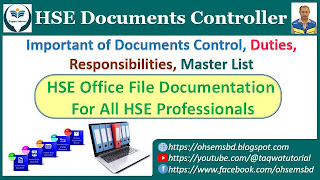OHSEMS
Health
Health means free from the complete physical, mental, illness, and disease, of the employees in an organization. Health refers to the well-being of the inner organs of the human body such as the well-being of the lungs and respiratory system.
Safety
Safety means managing unintended loss.
Safety means freedom from an acceptable risk.
Analysis of Safety –
- Search for hazards
- Analyze the risk
- Find the cause
- Eliminate the cause
- Tell others
- You are safe!
Safety means free from hazard, risk, and injury in an organization or occupational workplace. Safety refers to machines, planets, and the inner & outer safety of the human body.
Safety is protected from unintended loss or other non-desirable outcomes to cause danger, risk, or injury. Safety can also refer to the control of avowed hazards to achieve an acceptable level of risk.
“Safety means keeping yourself and others free from harm or danger. Safety always to avoid incidents, accidents or reduce risk.”
Environment
Environment means free from pollution of air, water, and soil. The working conditions must be safe for the human body.
The sum of the total of the elements, factors, and conditions in the surroundings that may have an impact on the development, action, or survival of an organism or group of organisms.
The aggregate of all external conditions and influences affecting the life and development of an organism, human behavior, or society. Major elements of the environment are Physical, Biological, Social, and Economic.
Environment Sanitation (Environmental Health):
The control of all those factors in man’s physical environment that exercise or may exercise a deleterious effect on his physical development, health, and survival.
Safety Management System (SMS)
A safety management system is a systematic approach to managing safety, including organizational structures, accountabilities, policies, and procedures. An SMS is scalable so it can be tailored to the size and complexity of your organization.
SMS includes four main components –
- Safety policy and objectives
- Safety risk management
- Safety assurance
- Safety promotion
10 Life-Saving Rules (LSR)
1. Work authorization – Obtain a valid permit whenever required
2. Energy isolation – Verify isolation & zero energy before begins
3. Bypassing safety controls – Obtain authorization before overriding or disabling safety controls
4. Line of fire – Keep yourself & others out of the line of fire
5. Hot work – Control flammable & ignition source
6. Work at height – Protect yourself against a fall when working at height
7. Driving – Follow safe driving rules
8. Safe mechanical lifting – Plan lifting operations & control the area
9. Toxic gas – Follow the rules of working in a toxic gas environment (CO, H2S)
10. Confined space – Obtain authorization before entering a confined space
Safety Key Components of a Successful Safety Management Program
- Safety assessment
- Hazard Identification
- Daily Observation
- Safety Committee
- Fire & Disaster Team
- Fire safety Manual
- Factory Evacuation Plan
- Factory Egress Map
- Emergency Preparedness Plan (EPP)
- Fire drill procedure
- Fire drill execution
- Evacuation procedure
- Evacuation execution
- Fire Extinguishers, Fire Hydrant, FHC & FDC Layout
- Fire extinguisher calibration record
- Work permit
- Investigation record
- Create Self-Awareness
- Training program
- Conduct training
- Toolbox talk
- Safety Signs
- Visitor safety orientation at the gate
- Safety orientation for all employee
- Security detection system procedure
- RA
- JSA
- OCP
- SOT
- Checklist
- Maintain Safety Record
EHS Monthly Dashboard
An Environment Health and Safety (EHS) dashboard provides EHS information about the organization that shows important EHS metrics and KPIs in real time. Learn how to create an automated EHS Dashboard from Excel link to PowerPoint.
Work Permit
Different types of permits to work used at factories or shipyards
- Entry Permit
- Hot work permit
- Painting permit
- Blasting
- Scaffold
- Blasting / De blasting
- Bunkering
- Testing of a heating coil
- Testing of hydraulic system
- Dismantling of cargo line
- Dismantling of valve
- Chemical Cleaning
- Opening of the main hole
- Cleaning of switchboard
- Feeding of dry ice
- Servicing of CO2 system
- Transferring of oil
- Tank cleaning
- Radiography
- Cleaning of generator





Comments
Post a Comment